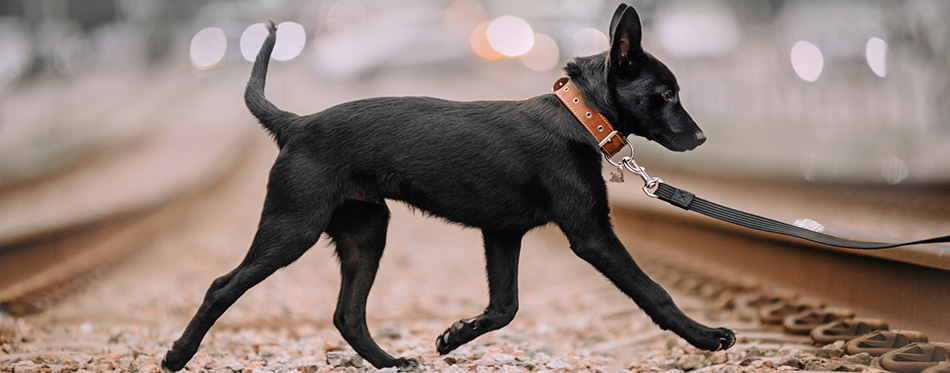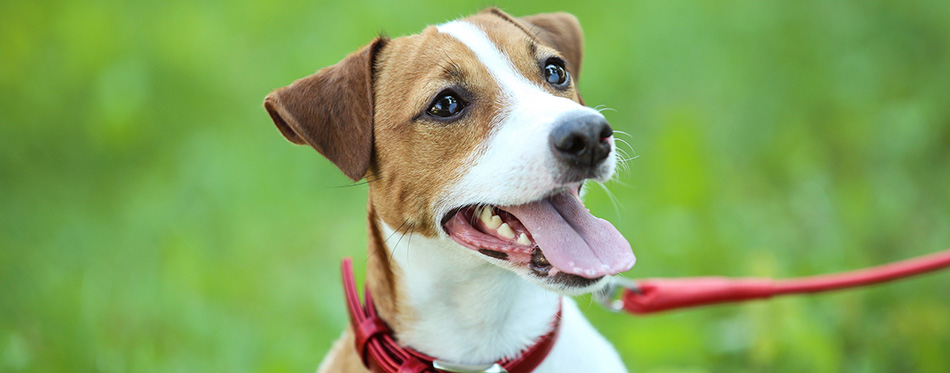Dog leashes are essential in keeping your dog in a safe distance when out walking or jogging. Aside from the fact that it gives you control over your dog (whose curiosity and excitement is usually heightened during walks outside), it also helps you to keep it away from danger. Dog leashes also ensure that your dog remains in view and, therefore, removes the dangers of it getting lost or being snatched by dog thieves. The problem for most dog owners is leash training. It is never too late to learn how to train a puppy to walk on a leash. Although it may seem quite a task, leash training a puppy or a dog is quite simple. In this article, you will learn how to leash train a dog in a few simple steps.
Begin With A Collar
The first thing to know about how to leash train a puppy is that it is less difficult for a puppy to wear a leash when it is already used to wearing a collar. The good thing is that a lot of puppies are already used to wearing collars as the latter holds their identification tags. If your dog or puppy is not used to a dog collar, you should get one immediately. Once you have your dog collar, do not be in haste to get your dog to put it on. Instead, take your time with it. Give your dog or puppy enough time to get used to the collar. Allow your dog to walk around the house in the collar for a couple of weeks first before you move to the next stage. Because we are focusing on training your dog to walk on a leash, the best kind of collar that will suit our purpose is a flat nylon or a leather dog collar that comes with a buckle made of metal and enough space to fit a couple of fingers.

The No-Pull Harness
Once you have gone past the first stage (getting your dog used to a collar), it is time to introduce your dog to the leash. If you own a large dog breed that is super hyper, hot-headed and has a lot of pulling power, it is best (and safer) to opt for a no-pull harness as this will keep your dog from yanking you off your feet and pulling you down the street. There are several types of no-pull harnesses to choose from. And, each of them will help train your dog to walk on a leash without yielding to the temptation to pull away from you. This leash uses a simple mechanism; it is connected to the harness at the front side where your dog’s chest is. Thus, when your dog tries to pull away, the harness will turn the dog backward instead to face you. Hence, with time, your dog will be discouraged from the act and will stop trying to pull away from you. The next thing to do while your dog is learning to use the harness for the first time is to encourage your dog to sniff the harness. As soon as the dog becomes comfortable with the smell, things will become a lot easier for you. To do this, always hold the harness closer to the dog’s nose and allow it to sniff at it several times. Do not forget to reward your dog with treats throughout the process. Take a look at our review of dog harnesses and puppy harnesses for more options
The Leash
So, you have successfully managed to get your dog used to wearing the harness. It is time to move to the next step, which is picking out the right leash. Not every leash is designed for every dog. If you own a large breed of dog, it is best to opt for a heavy leather leash. If you have a small size dog, then a lightweight leash made of nylon will be the ideal option. When shopping for a leash, it is best to stay away from the retractable dog leashes at this point. This is because, unlike the no-pull leash, the retractable leash can encourage your dog to pull away from you. Another thing to keep in mind when purchasing a leash is the size. For starters, it is best to opt for a leash that is about six feet long. This is because it will give your dog enough room to be curious and excited while keeping you in control. This will be especially beneficial to puppies as they’re usually more curious. Also, be sure to purchase a leash that fits comfortably on your dog. It should be too tight as your dog will feel uncomfortable, or too loose as it may easily slide off.
Get Your Dog Used To The Leash
Just like you did with the collar or harness, do not jump right into walking your dog on a leash as soon as you buy one. Give your time to get used to it first. To do this, start by putting the leash in view by keeping it close to its food bowl. This will also give your dog the chance to sniff it and get familiar with it. Next, associate the leash with treats. Try keeping a bowl of treats near the leash for your dog. This will help your dog to associate the leash with treats and, thus, make it less difficult for your dog to warm up to it. Next, fix the leash to your dog’s harness and allow your dog to walk around the house with the leash for a few minutes then take it off. Try the next day again for a few minutes while holding on to the leash. This time, allow the leash to stay on for a longer period of time. Do not forget to always have your dog’s treat with you as you need to reward it frequently throughout the process.
Practice Leash Walking: Step One
Before you start the actual leash walking practice, your dog needs to learn some basic commands such as sit and stop. These are very important in ensuring that your dog does stride too far off from you. It also helps in keeping its pumped up and excited nature in check. You can try this by holding out a treat beside you while beckoning your dog to walk close by you. Next, come to a halt and beckon your dog to do likewise as you hold out a treat in its view. Always remember to give your dog the treat whenever it successfully obeys your command. Try this process several times at home until you are certain that your dog is able to obey your commands. If you are having difficulty in training your dog by yourself, you can always seek the assistance of professional dog trainers.
Practice Leash Walking: Step Two
Now, it is time for the leash walking proper. After your dog has successfully learned to obey your simple commands, it is time to turn up the speed a notch higher. Try getting your dog to walk on the leash at a faster pace around the house. While doing this, give frequent commands to stop, sit, and walk beside you. Do not forget to always have some treats with you. Next, take your dog outside and go for a walk around the house while issuing out the same commands as often as you want. Once you are convinced that your dog ready, the lessons are complete.

Troubleshooting Leash Training
Although you have successfully trained your puppy on how to walk on a leash, there is no guarantee that it will maintain that discipline throughout its growing years. Just like most animals, your dog will act on impulse most of the time when you are outside having a walk. Thankfully, there are a few things you can do to handle these situations.
When your dog pulls: Out of excitement or curiosity, your dog will try to pull away from you at one point to its object of interest. All you need to do in this situation is to come to a halt and remain grounded until your dog stops pulling. Do not try to drag your dog with you or yank it. Just stay grounded. This option is an alternative to no-pull leashes.
Traffic: Your dog may get overwhelmed and confused during heavy traffic. Always reduce the length of the leash during such occasions to keep your dog closer to you.
Barking: When outside, there are a lot of things that will seem threatening to your dog and cause it to bark; it could be the presence of other dogs, other animals, or some people. The first thing to do during such moments is to distract your dog with a treat. Once its attention is away from the distracting object, stroke it for a while, giving it a couple more treats.
To Summarize
Leash training your puppy is not as difficult as it seems. With a lot of patience (and treats), you will have your dog ready and going in a couple of weeks. It is always important to first establish command over your dog to make its training easier. It is equally important always to reward your pup every step of the way for every little progress made.

